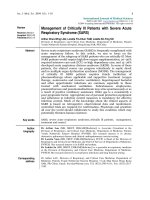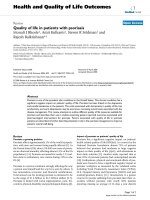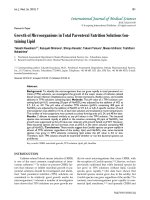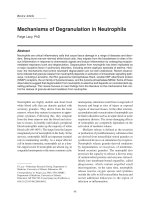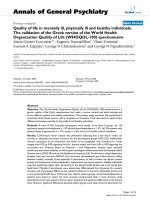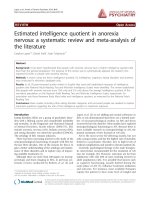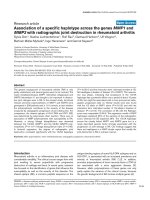Báo cáo y học: "Pharmacokinetics of epinephrine in patients with septic shock: modelization and interaction with endogenous neurohormonal status" pdf
Bạn đang xem bản rút gọn của tài liệu. Xem và tải ngay bản đầy đủ của tài liệu tại đây (226.86 KB, 8 trang )
Open Access
Available online />Page 1 of 8
(page number not for citation purposes)
Vol 13 No 4
Research
Pharmacokinetics of epinephrine in patients with septic shock:
modelization and interaction with endogenous neurohormonal
status
Imad Abboud
1
, Nicolas Lerolle
1
, Saik Urien
2
, Jean-Marc Tadié
1
, Françoise Leviel
3
, Jean-
Yves Fagon
1
and Christophe Faisy
1
1
Medical Intensive Care Unit, Hôpital Européen Georges Pompidou, Assistance Publique-Hôpitaux de Paris, Université Paris – Descartes, Paris,
France
2
E.A. 3620, CIC-0109 Cochin-Necker Paris Descartes, Unité de Recherche Clinique, Tarnier Hospital, Assistance Publique-Hôpitaux de Paris,
Université Paris – Descartes, Paris, France
3
Department of Physiology, Hôpital Européen Georges Pompidou, Assistance Publique-Hôpitaux de Paris, Université Paris – Descartes, Paris, France
Corresponding author: Nicolas Lerolle,
Received: 20 Mar 2009 Revisions requested: 24 Apr 2009 Revisions received: 26 Jun 2009 Accepted: 21 Jul 2009 Published: 21 Jul 2009
Critical Care 2009, 13:R120 (doi:10.1186/cc7972)
This article is online at: />© 2009 Abboud et al.; licensee BioMed Central Ltd.
This is an open access article distributed under the terms of the Creative Commons Attribution License ( />),
which permits unrestricted use, distribution, and reproduction in any medium, provided the original work is properly cited.
Abstract
Introduction In septic patients, an unpredictable response to
epinephrine may be due to pharmacodynamic factors or to non-
linear pharmacokinetics. The purpose of this study was to
investigate the pharmacokinetics of epinephrine and its
determinants in patients with septic shock.
Methods Thirty-eight consecutive adult patients with septic
shock were prospectively recruited immediately before
epinephrine infusion. A baseline blood sample (C
0
) was taken to
assess endogenous epinephrine, norepinephrine, renin,
aldosterone, and plasma cortisol levels before epinephrine
infusion. At a fixed cumulative epinephrine dose adjusted to
body weight and under steady-state infusion, a second blood
sample (C
1
) was taken to assess epinephrine and
norepinephrine concentrations. Data were analyzed using the
nonlinear mixed effect modeling software program NONMEM.
Results Plasma epinephrine concentrations ranged from 4.4 to
540 nmol/L at steady-state infusion (range 0.1 to 7 mg/hr;
0.026 to 1.67 μg/kg/min). A one-compartment model
adequately described the data. Only body weight (BW) and
New Simplified Acute Physiologic Score (SAPSII) at intensive
care unit admission significantly influenced epinephrine
clearance: CL (L/hr) = 127 × (BW/70)
0.60
× (SAPS II/50)
-0.67
.
The corresponding half-life was 3.5 minutes. Endogenous
norepinephrine plasma concentration significantly decreased
during epinephrine infusion (median (range) 8.8 (1 – 56.7) at C
0
vs. 4.5 (0.3 – 38.9) nmol/L at C
1
, P < 0.001).
Conclusions Epinephrine pharmacokinetics is linear in septic
shock patients, without any saturation at high doses. Basal
neurohormonal status does not influence epinephrine
pharmacokinetics. Exogenous epinephrine may alter the
endogenous norepinephrine metabolism in septic patients.
Introduction
Symptomatic treatment of septic shock is primarily aimed at
improving hemodynamic and oxygen transport variables in
order to restore organ perfusion. Hemodynamic stabilization in
septic shock is achieved through adequate volume resuscita-
tion and the use of vasoactive agents. In the past decade,
dopamine and norepinephrine were considered to be the
drugs of choice to increase arterial pressure, rather than
epinephrine, which alters metabolism substantially [1-4]. How-
ever, Annane and colleagues reported similar efficacy and
safety when comparing norepinephrine with epinephrine com-
bined with dobutamine [5].
Clinical experience suggests a considerable intra and inter-
patient variability of arterial pressure in response to epine-
phrine infusion. A ceiling effect frequently occurs in more
severe cases, requiring maximum epinephrine doses in which
further increases in infusion rate lead to modest or no increase
BSV: between-subject variability; BW: body weight; C
0
: initial blood sample; C
1
: second blood sample; CL: plasma clearance; HPLC: high-pressure
liquid chromatography; ICU: intensive care unit; R0: baseline rate of epinephrine infusion; SAPS II: new simplified acute physiology score; SD: stand-
ard deviation; V: volume of distribution; ω
2
CL: variances of BSV; ωCL: standard deviations of BSV.
Critical Care Vol 13 No 4 Abboud et al.
Page 2 of 8
(page number not for citation purposes)
in blood pressure. This unpredictable response may be due to
pharmacodynamic factors or non-linear pharmacokinetics.
Free radicals and nitric oxide produced in sepsis are able to
oxidize and neutralize catecholamines and may therefore
enhance catecholamine clearance [6,7]. In a rat model of sep-
sis, inhibition of free radical production prevented the drop in
catecholamine blood concentrations and hypotension [7]. In
addition, it was suggested that proinflammatory mediators
may also neutralize catecholamines [7]. Conversely, liver and
kidney dysfunction may lower epinephrine clearance, and
exogenously administered epinephrine may accelerate the
release of endogenous epinephrine via the sympathetic nerve
endings and the adrenal medulla [8,9]. Finally, adrenal status
and physiological doses of hydrocortisone influence the pres-
sor response to vasoactive drugs [10]. The mechanisms by
which glucocorticoid hormones modulate the vascular
response to vasopressors are not well known, and a pharma-
cokinetic alteration may occur.
The purpose of this study was to investigate the pharmacoki-
netics of epinephrine in patients with septic shock, assuming
that a ceiling may be observed at high doses. In addition, we
assessed whether endogenous neurohormonal status alters
epinephrine pharmacokinetics. We demonstrated that epine-
phrine pharmacokinetics is linear in septic shock patients,
without any saturation at high doses, and that higher disease
severity is associated with lower epinephrine clearance. Fur-
thermore, basal neurohormonal status did not influence epine-
phrine pharmacokinetics.
Materials and methods
This prospective study was conducted in the 18-bed medical
intensive care unit (ICU) of a tertiary teaching hospital in
France from January to June 2006. The Ethics Committee of
the Société de Réanimation de Langue Française approved
the study and waived the need for written informed consent.
Participants, or immediate family members if a patient was
unable to respond, were informed of the objectives of the pro-
cedure and oral consent was obtained. All consecutive adult
patients with septic shock were eligible. Septic shock was
defined by the presence of infection, dysfunction in at least
one organ and fluid refractory hypotension (mean arterial pres-
sure below 65 mmHg) requiring the administration of vaso-
pressor agents [11]. Exclusion criteria were pregnancy, renal
replacement therapy during the study period and administra-
tion of catecholamines in the 24 hours preceding enrolment.
Patients were included in the study when the attending physi-
cian considered vasopressor infusion. They were thus enrolled
before the onset of infusion.
Intervention
As standardized in our ICU, epinephrine was used as the first-
line vasopressor. Epinephrine (diluted to 1:10 in 0.9% saline)
was started intravenously using a programmable syringe pump
(Pilote IEC, Fresenius-Vial, Bressins, France) at a rate of 0.15
μg/kg/min. The infusion rate was then adjusted to obtain a
mean arterial pressure between 65 and 75 mmHg. Of note,
continuous epinephrine infusion is required in septic shock
patients to maintain arterial pressure until the patient's hemo-
dynamic status improves, generally over several hours or days;
thus duration of perfusion or total cumulative dose cannot be
predicted. In this study, neither intravenous hydrocortisone nor
recombinant human activated protein C were used, and epine-
phrine was the exclusive catecholamine used.
Blood sampling
An initial blood sample (C
0
) was drawn within the 15 minutes
preceding epinephrine infusion. A second blood sample (C
1
)
was drawn when the cumulative epinephrine dose adjusted to
body weight (BW) reached a threshold fixed arbitrarily at 0.15
mg/kg, provided the epinephrine infusion rate remained steady
and fluid loading was not used in the preceding 15 minutes. In
the case of modification of the epinephrine infusion rate or fluid
loading in the 15 minutes preceding the threshold dose, C
1
was delayed until a 15-minute period of stability for the infu-
sion rate was obtained. The 15-minute steady-state interval
was chosen according to epinephrine plasmatic half-life in
healthy subjects [12]. The epinephrine infusion rate (mg/hr) at
C
1
time was recorded. Blood drawn on C
0
was used to assess
plasma levels of endogenous adrenal axis hormones: epine-
phrine, norepinephrine, renin, aldosterone, and cortisol. Blood
drawn on C
1
allowed for the measurement of epinephrine and
norepinephrine plasma levels.
Sample handling
Blood assigned to catecholamine assays was sampled in
EDTA-tubes and immediately centrifuged at 3000 g for five
minutes. The plasma samples were then immediately stored at
-80°C before assay. Blood assigned to renin and aldosterone
assays was also sampled in EDTA-tubes and centrifuged at
3000 g for five minutes. The plasma was then separated and
stored at -20°C. Blood assigned for cortisol assays was
allowed to clot at room temperature for 30 minutes, then cen-
trifuged at 3000 g for five minutes. Samples were stored at -
20°C.
Assays
Epinephrine and norepinephrine concentrations were meas-
ured in plasma using high-pressure liquid chromatography
(HPLC) with coulometric detection [13,14]. The limit of quan-
tification (defined by a variability between measurements of
<10%) for HPLC was 0.10 nmol/L. The epinephrine concen-
tration measured on C
1
was the sum of endogenous and exog-
enous epinephrine, as the two compounds are strictly identical
with regard to chromatographic detection. Plasma aldoster-
one was measured in duplicate by RIA using a commercial kit
from the Diagnostic Products Corporation (Los Angeles, CA,
USA). Renin and cortisol concentrations were measured on a
fully automated chemiluminescence analyzer (LIAISON
®
Ana-
lyzer, DiaSorin S.p.A, Salluggia-Vercelli, Italy). Plasma renin
Available online />Page 3 of 8
(page number not for citation purposes)
concentration was measured with a Direct Renin assay. This
two-site immunometric assay was calibrated according to
World Health Organization reference material (National Insti-
tute for Biological Standards and Control, code 58/356). Nor-
mal ranges in the supine position for plasma renin,
aldosterone, and cortisol concentrations were 10 to 25 mU/L,
80 to 400 pmol/L, and 330 to 500 nmol/L, respectively.
Patient data
Baseline demographic data included sex, age, BW, new sim-
plified acute physiology score (SAPS) II at study inclusion
[15], ICU length of stay before inclusion and cause of septic
shock. The volume of fluid administered for resuscitation of
shock before C
1
was recorded. Invasive blood pressure and
heart rate were collected at C
0
and C
1
.
Population pharmacokinetics modeling of epinephrine
Data were analyzed using the nonlinear mixed effect modeling
software program NONMEM version VI driven by Wings for
Nonmem (WfN, Free Software Foundation, Boston, MA, USA)
[16]. The FOCE method was used. This method allows for the
estimation of both the pharmacokinetic and statistic parame-
ters of the model, that is, the elimination clearance is estimated
along with its corresponding between-subject variability
(BSV). Any residual variability, including measurement errors,
can also be estimated. Epinephrine pharmacokinetics was
ascribed to a one-compartment open model with first order
elimination. Parameters for the model were plasma clearance
(CL), volume of distribution (V), and baseline rate of epine-
phrine infusion (R0). The R0 parameter allowed us to take into
account the baseline epinephrine concentration at C
0
. BSVs
were assumed to be exponential and their variances and
standard deviations (SD) were denoted as ω
2
CL and ωCL,
respectively. Covariances were also estimated. When a full
covariance matrix could not be estimated, the following algo-
rithm was applied: ω
2
CL was always retained; and if the cor-
relation between terms was low, it was fixed at 0.
Proportional, additive or mixed error models were investigated
to describe any residual variability. The main covariates of
interest in the population were sex, age, BW, SAPS II, volume
of liquid infused, and plasma hormone concentrations. Param-
eter estimates were standardized for a mean standard covari-
ate using an allometric model: P
i
= P
STD
× (BW
i
/BW
STD
)
θBW
where P
STD
and θ
BW
are the standard parameter value for a
patient with the standard BW value and the power parameter
estimate for BW, and P
i
and BW
i
are the parameter and BW
of the ith individual. Graphical evaluation of goodness-of-fit
was mainly assessed by observed vs. predicted concentra-
tions and weighted residuals vs. time and/or weighted residu-
als vs. predicted concentrations. The final population model
was also ascertained by normalized prediction distribution
error metrics [17]. The stability of the model and accuracy of
the parameters were assessed by a bootstrap method imple-
mented in Wings for Nonmem [18] and diagnostic graphics
and distribution statistics were obtained using R for Nonmem
[18] via the R program [19].
Statistics
The sample size was calculated based on data from a previous
study where the lower limit of the 95% confidence interval of
the correlation coefficient r
2
between epinephrine perfusion
rate and its plasma concentration was 0.4. To detect such a
correlation (we used a β risk of 20% and an α risk of 5%), 28
patients or more were required. Results are expressed as num-
bers (%), means ± SD, or medians (range) for data not nor-
mally distributed. Analyses were conducted with SPSS 11.5
software (SPSS Inc., Chicago, IL, USA). Wilcoxon and Mann-
Whitney tests were applied for comparison of relevant varia-
bles. Shapiro-Wilks test was used for the assessment of nor-
mality. We considered a difference to be significant when the
α risk was < 5% (P < 0.05).
Results
Patient population
Thirty-eight consecutive patients satisfying the entry criteria
were recruited and had their plasma epinephrine concentra-
tions analyzed. We were able to sample C
1
at the exact thresh-
old dose in all of these patients. Characteristics and
demographic data of the enrolled patients are summarized in
Table 1. Three C
1
plasma tubes assigned for epinephrine and
norepinephrine blood concentrations were lost due to a tech-
nical problem during handling.
Table 1
Patientcharacteristics (n = 38)
Characteristic Value
Age, years, mean ± SD 64 ± 15
Gender, male, n (%) 25 (65.7)
Body weight, kg, mean ± SD 68 ± 19
SAPS II at study inclusion, mean ± SD 64 ± 23
Days in ICU before inclusion, median (range) 1 (1 to 22)
ICU mortality, n (%) 25 (65.7)
Causes of septic shock
Community-acquired pneumonia 10
Nosocomial pneumonia 12
Mediastinitis 4
Intra-abdominal infection 6
Others 4
Not documented 2
ICU = intensive care unit; SAPS II = new simplified acute physiology
score; SD = standard deviation.
Critical Care Vol 13 No 4 Abboud et al.
Page 4 of 8
(page number not for citation purposes)
Hemodynamics and plasma hormone concentrations
Epinephrine infusion significantly increased arterial blood
pressure and heart rate from C
0
to C
1
, and was associated
with a significant decrease in plasma norepinephrine concen-
tration (Table 2). The median fluid volume administered for
shock resuscitation until C
1
was 4650 ml (range 500 to
11,400). In all patients, 90% of this volume had been adminis-
tered before C
0
.
Epinephrine pharmacokinetics
Thirty-eight patients and 73 plasma epinephrine concentra-
tions were available for pharmacokinetics evaluation. The
median delay from the start of epinephrine infusion to C
1
was
415 minutes (range 90 to 1260). Despite the fact that the
drug dosage was arbitrarily normalized on BW, the infusion
rates varied widely at C
1
due to the significant variations in
patients' requirements to achieve hemodynamic goals: there
was a greater than 100-fold difference between the lowest
and highest rates (Table 2). A one-compartment model ade-
quately described the data. In a first step, only BSV for CL
(ωCL) and an additive component for the residual variability
could be estimated. The use of a one-compartment model with
Michaelis-Menten (saturable) elimination did not improve fit
and could not provide reliable Vmax and Km estimates. How-
ever, the accuracy of the residual variability parameter was
very poor. Thus, in a second step, the residual variability
parameters were fixed as follows: 10% and 0.1 nmol/L for the
proportional and additive components, according to the assay
quantification as stated in Methods. In this manner, the BSV
for CL and R0 could be accurately estimated. The parameter
estimates of this basic model were CL, 108 L/hr (ωCL = 0.44),
V, 9.1 L, and R0, 43.5 nmol/hr (ωR0 = 1.21). The correspond-
ing half-life was 3.5 minutes. The accuracy of estimates varied
from 6% for CL to 36% for V. Only BW and SAPS II at ICU
admission significantly influenced epinephrine CL, reducing
the objective function value by 20 units and ωCL to 0.33. The
final relationship for epinephrine CL was thus: CL
i
(L/hr) = 127
× (BW/70)
0.60
× (SAPS II/50)
-0.67
where 127 L/hr is the typi-
cal CL for an individual weighing 70 kg with a SAPS II of 50.
This relationship shows that CL increases with BW and
decreases with SAPS II. Using CL, the prediction of the epine-
phrine plateau concentration at the steady-state infusion rate
was: C
plateau
(nmol/L) = (rate of infusion + R0)/(127 × (BW/
70)
0.60
× (SAPS II/50)
-0.67
). Baseline norepinephrine, aldoster-
one, renin, and cortisol blood concentrations as well as volume
of liquid administered for shock resuscitation had no impact on
CL. Table 3 summarizes the final population pharmacokinetics
estimates including the bootstrap verification. Figure 1 depicts
Table 2
Hemodynamic parameters and plasma hormone concentrations
Parameter Baseline (C
0
) 0.15 mg/kg Epinephrine (C
1
) P value
Epinephrine infusion rate
mg/hr - 2 (0.1 to 7)
μg/kg/min - 0.52 (0.026 to 1.7)
nmol/hr - 10 090 (545 to 38 208)
Hemodynamics
Heart rate 109 ± 22 117 ± 22 <0.05
Systolic blood pressure, mmHg 80 ± 13 116 ± 21 <0.0001
Diastolic blood pressure, mmHg 38 ± 9 56 ± 12 <0.0001
Mean blood pressure, mmHg 52 ± 8 76 ± 14 <0.0001
Plasma hormone concentrations
Epinephrine, nmol/L 0.34 (0.10 to 4.3) 95.8 (4.40 to 540)
a
<0.0001
Norepinephrine, nmol/L 8.8 (0.99 to 56.7) 4.5 (0.30 to 38.9)
a
<0.0001
Aldosterone, pmol/L 281 (17 to 1478) -
Cortisol, nmol/L 762 (170 to 7220) -
Renin, UI/L 198 (6.5 to 1246) -
Values at baseline (C
0
) and at fixed cumulative dose (0.15 mg/kg) of epinephrine infusion (C
1
). Data are median (range) or mean ± standard
deviation.
a
Three pieces of data missing.
Available online />Page 5 of 8
(page number not for citation purposes)
the predicted versus observed concentrations and Figure 2
shows the corresponding normalized prediction distribution
error test for this data.
Discussion
In this study, we observed that epinephrine pharmacokinetics
were linear in septic shock patients. Epinephrine clearance
was dependent on BW and disease severity as estimated by
the SAPS II. Increased disease severity was associated with
lower clearance. Conversely, basal neurohormonal status was
not shown to affect epinephrine pharmacokinetics. Finally, we
observed that exogenous epinephrine altered norepinephrine
metabolism in septic shock patients.
The linear pharmacokinetics of epinephrine and its decreased
clearance with increasing severity of disease did not suggest
a significant alteration of infused epinephrine by reactive oxy-
gen species or inflammatory cytokines. However, in the
absence of any measurement of the production of reactive oxy-
gen species and oxidized catecholamine metabolites, we can-
not exclude a small influence of oxidative stress on epinephrine
pharmacokinetics. By contrast, liver and kidney alterations may
have reduced the extra-neuronal monoamine transporters,
which in turn would decrease epinephrine clearance [8,9].
Additionally, renalase, a newly discovered amine oxidase that
specifically degrades circulating catecholamines, is secreted
by the kidney and has already been shown to be diminished in
chronic renal failure [20]. An involvement of this enzyme in
acute conditions merits further study.
The linear pharmacokinetics of epinephrine has already been
described in studies of very low doses of epinephrine in adult
volunteers [21]. In a small pediatric population, Fisher and col-
leagues reported a weak correlation between epinephrine
doses and concentrations [22]. However, in their study, lower
epinephrine infusion rates were used and other catecho-
lamines such as dobutamine and dopamine, which are known
to modulate epinephrine pharmacokinetics, were infused con-
comitantly [22-24]. Notwithstanding, we found an epinephrine
clearance close to the epinephrine plasma metabolic clear-
ance rate observed in this study. An influence of SAPS II on
catecholamines has already been reported with norepine-
phrine in septic shock and trauma patients [25]. Wilkie and
Figure 1
Goodness-of-fit plot for the final model, observed vs. model-predicted epinephrine plateau concentrationsGoodness-of-fit plot for the final model, observed vs. model-predicted
epinephrine plateau concentrations. The prediction of the epinephrine
plateau concentration at steady state infusion rate is: C
plateau
(nmol/L) =
(rate of infusion + R0)/(127 × (BW/70)
0.60
× (SAPS II/50)
-0.67
) where
R0 (nmol/hr) is the baseline rate of epinephrine infusion rate, BW (kg)
is the body weight, and SAPS II is the severity score (new simplified
acute physiology score) at intensive care admission.
Figure 2
Goodness-of-fit plot for the final model, normalized prediction distribu-tion errorsGoodness-of-fit plot for the final model, normalized prediction distribu-
tion errors. The upper frame shows normalized prediction distribution
errors (npde) vs. duration of epinephrine perfusion (delay C
0
to C
1
) and
the lower frame npde vs. model-predicted concentrations. The npde
distribution was not significantly different from normality (P = 0.10 by
Shapiro-Wilks test). Npde statistics are based on estimates of unbi-
ased means and variances of the observations using 500 Monte Carlo
simulations of the final model (the calculations include a de-correlation
step of the prediction errors).
Critical Care Vol 13 No 4 Abboud et al.
Page 6 of 8
(page number not for citation purposes)
colleagues reported age-dependent changes in plasma cate-
cholamine metabolic clearance rate in humans [26]. This influ-
ence of age is in agreement with our model, because age is a
component of SAPS II.
In our study, basal endogenous epinephrine concentrations
were higher than those of resting healthy adults [21,27-29]
but lower than those found in a previous population of patients
with septic shock [30]. This is likely to be because of differ-
ences in study populations (surgical patients with septicemia,
traumatic, or hemorrhagic shock). The decrease in endog-
enous norepinephrine concentrations during epinephrine infu-
sion has not been described previously. An epinephrine-
induced inhibition of norepinephrine release from sympathetic
neuronal endings has been demonstrated [31,32]. A direct
feedback control of epinephrine concentration on norepine-
phrine secretion by the adrenal gland has also been described
[33]. Finally, this drop in endogenous norepinephrine sug-
gests the absence of accessory metabolic pathways convert-
ing exogenous epinephrine to norepinephrine.
The influence of BW and disease severity on epinephrine
pharmacokinetics may account for some of the inter-patient
variability in response to epinephrine infusion. The lack of
impact of endogenous adrenal axis hormones on epinephrine
pharmacokinetics suggests that the improvement in hemody-
namics with corticoid substitutive dose in septic shock
patients is not related to an alteration of catecholamines phar-
macokinetics [10]. Indeed, many pharmacodynamic factors
influence the response to catecholamine administration in crit-
ically ill patients; previous studies have shown that continuous
administration of vasoactive drugs may lead to desensitization
of vascular smooth muscle responsiveness and that vascular
contractility is depressed by proinflammatory mediators, nota-
bly through alterations to adrenergic receptor density and
affinity, and by disruption of signal transduction across the cell
membrane [25,34-36].
A limit to this study is that epinephrine concentration during
infusion was available for only one infusion rate in each patient.
However, this was balanced by a relatively large number of
septic patients studied. Mainly, patients received epinephrine
as the first-line catecholamine, with no other catecholamines.
Finally, as we included only patients with septic shock, our
results cannot be extended to other etiologies of shock.
Conclusions
These results show linear epinephrine pharmacokinetics and
no saturation at high doses in patients with septic shock. Only
BW and severity of illness influenced epinephrine pharmacok-
inetics. No interaction between exogenous epinephrine and
endogenous adrenal axis plasma hormones was observed.
These results are a prerequisite for further studies on epine-
phrine pharmacodynamics.
Competing interests
The authors declare that they have no competing interests.
Table 3
Population pharmacokinetic parameters of epinephrine in 38 patients with septic shock and bootstrap statistics
Parameter Mean SE (%) Median
a
5
th
to 95
th
percentiles
a
CL (L/hr/70 kg BW/50 SAPS II units) 127 6.0 125 115 to 140
V (L) 7.9 36 7.4 1 to 13
R0 (nmol/h) 43.5 24 43 1 to 65
θ
BW
effect on CL 0.60 33 0.59 0.23 to 0.95
θ
SAPS II
effect on CL -0.67 21 -0.65 -0.91 to -0.43
BSV(CL) (square root of ω
2
CL
) 0.33 31 0.30 0.20 to 0.39
BSV(R0) (square root of ω
2
R0
)1.23201.231 to 2.85
Residual variability, proportional component 0.1
b
NA NA NA
Residual variability, additive component, nmol/L 0.1
b
NA NA NA
a
Statistics from 387 bootstrap runs (13 abnormal termination runs). Non parametric 90% confidence interval based on the 5
th
to 95
th
percentiles.
b
Fixed values.
BSV = between subject variability; BW = body weight; CL = epinephrine clearance; NA = not applicable; R0 = baseline rate of epinephrine
infusion; SAPS II = new simplified acute physiology score; SE (%) = standard error of estimate in %; V = epinephrine distribution volume.
θ
BW
effect on CL, CL = 127 (BW/70)
0.60
, the individual CL increases or decreases as a function of BW, it is > 127 L/hr if BW is > 70 kg and <
127 L/hr if BW < 70 kg. θ
SAPSII
effect on CL, CL = 127 (SAPSII/50)
-0.67
, the individual CL increases or decreases as a function of SAPS II score,
it is > 127 L/hr if SAPS II is < 50 and < 127 L/hr if SAPS II > 50 units.
Available online />Page 7 of 8
(page number not for citation purposes)
Authors' contributions
IA participated in the design of the study, enrolled the patients,
performed blood sampling, and drafted the manuscript. NL
participated in the study coordination, interpreted the data,
and drafted the manuscript. SU performed modelization, per-
formed statistical analyses, interpreted the data, and drafted
the manuscript. JMT participated in the design and coordina-
tion of the study. FL performed hormone concentration meas-
urements, and interpreted the data. JYF participated in the
design and coordination of the study. CF conceived the study,
participated in its design and coordination, and drafted the
manuscript. All authors read and approved the final manu-
script.
References
1. Vincent JL, de Backer D: The International Sepsis Forum's con-
troversies in sepsis: my initial vasopressor agent in septic
shock is dopamine rather than norepinephrine. Crit Care
2003, 7:6-8.
2. Vincent JL, De Backer D: Inotrope/vasopressor support in sep-
sis-induced organ hypoperfusion. Semin Respir Crit Care Med
2001, 22:61-74.
3. Sharma VK, Dellinger RP: The International Sepsis Forum's
controversies in sepsis: my initial vasopressor agent in septic
shock is norepinephrine rather than dopamine. Crit Care
2003, 7:3-5.
4. Trager K, DeBacker D, Radermacher P: Metabolic alterations in
sepsis and vasoactive drug-related metabolic effects. Curr
Opin Crit Care 2003, 9:271-278.
5. Annane D, Vignon P, Renault A, Bollaert PE, Charpentier C, Martin
C, Troche G, Ricard JD, Nitenberg G, Papazian L, Azoulay E, Bel-
lissant E, CATS Study Group: Norepinephrine plus dobutamine
versus epinephrine alone for management of septic shock: a
randomised trial. Lancet 2007, 370:676-684.
6. Kolo LL, Westfall TC, Macarthur H: Nitric oxide decreases the
biological activity of norepinephrine resulting in altered vascu-
lar tone in the rat mesenteric arterial bed. Am J Physiol Heart
Circ Physiol 2004, 286:H296-303.
7. Macarthur H, Westfall TC, Riley DP, Misko TP, Salvemini D: Inac-
tivation of catecholamines by superoxide gives new insights
on the pathogenesis of septic shock. Proc Natl Acad Sci USA
2000, 97:9753-9758.
8. Eisenhofer G: The role of neuronal and extraneuronal plasma
membrane transporters in the inactivation of peripheral cate-
cholamines. Pharmacol Ther 2001, 91:35-62.
9. Eisenhofer G, Kopin IJ, Goldstein DS: Catecholamine metabolis:
a contemporary view with implication for physiology and med-
icine. Pharmacol Rev 2004, 56:331-349.
10. Annane D, Bellissant E, Sebille V, Lesieur O, Mathieu B, Raphael
JC, Gajdos P: Impaired pressor sensitivity to noradrenaline in
septic shock patients with and without impaired adrenal func-
tion reserve. Br J Clin Pharmacol 1998, 46:
589-597.
11. Levy MM, Fink MP, Marshall JC, Abraham E, Angus D, Cook D,
Cohen J, Opal SM, Vincent JL, Ramsay G: 2001 SCCM/ESICM/
ACCP/ATS/SIS International Sepsis Definitions Conference.
Intensive Care Med 2003, 29:530-538.
12. Cameron OG, Gunsher S, Hariharan M: Venous plasma epine-
phrine levels and the symptoms of stress. Psychosom Med
1990, 52:411-424.
13. Guillemin A, Troupel S, Galli A: Determination of catecho-
lamines in plasma by high-performance liquid chromatogra-
phy. Clin Chem 1988, 34:1913-1914.
14. Wang Y, Fice DS, Yeung PK: A simple high-performance liquid
chromatography assay for simultaneous determination of
plasma norepinephrine, epinephrine, dopamine and 3,4-dihy-
droxyphenyl acetic acid. J Pharm Biomed Anal 1999,
21:519-525.
15. Auriant I, Vinatier I, Thaler F, Tourneur M, Loirat P: Simplified
acute physiology score II for measuring severity of illness in
intermediate care units. Crit Care Med 1998, 26:1368-1371.
16. Beal SL, Sheiner LB: NONMEM user's guide. NONMEM project
group, San Francisco, University of california, USA. 1998.
17. Comets E, Brendel K, Mentre F: Computing normalised predic-
tion distribution errors to evaluate nonlinear mixed-effect
models: the npde add-on package for R. Comput Methods Pro-
grams Biomed 2008, 90:154-166.
18. Wings for NONMEM [
]
19. Ihaka R, Gentleman RR: A language for data analysis and
graphics. J Comput Graphic 1996, 5:299-314.
20. Xu J, Li G, Wang P, Velazquez H, Yao X, Li Y, Wu Y, Peixoto A,
Crowley S, Desir GV: Renalase is a novel, soluble monoamine
oxidase that regulates cardiac function and blood pressure. J
Clin Invest 2005, 115:1275-1280.
21. Clutter WE, Bier DM, Shah SD, Cryer PE: Epinephrine plasma
metabolic clearance rates and physiologic thresholds for met-
abolic and hemodynamic actions in man. J Clin Invest 1980,
66:94-101.
22. Fisher DG, Schwartz PH, Davis AL: Pharmacokinetics of exoge-
nous epinephrine in critically ill children. Crit Care Med 1993,
21:111-117.
23. Banner W Jr, Vernon DD, Dean JM, Swenson E: Nonlinear
dopamine pharmacokinetics in pediatric patients. J Pharmacol
Exp Ther 1989, 249:131-133.
24. Schwartz PH, Eldadah MK, Newth CJ: The pharmacokinetics of
dobutamine in pediatric intensive care unit patients. Drug
Metab Dispos 1991, 19:614-619.
25. Beloeil H, Mazoit JX, Benhamou D, Duranteau J: Norepinephrine
kinetics and dynamics in septic shock and trauma patients. Br
J Anaesth 2005, 95:782-788.
26. Wilkie FL, Halter JB, Prinz PN, Benedetti C, Eisdorfer C, Atwood
B, Yamasaki D: Age-related changes in venous catecholamines
basally and during epinephrine infusion in man. J Gerontol
1985, 40:133-140.
27. Cabal LA, Siassi B, Artal R, Gonzalez F, Hodgman J, Plajstek C:
Cardiovascular and catecholamine changes after administra-
tion of pancuronium in distressed neonates. Pediatrics 1985,
75:284-287.
28. Cryer PE, Rizza RA, Haymond MW, Gerich JE: Epinephrine and
norepinephrine are cleared through beta-adrenergic, but not
alpha-adrenergic, mechanisms in man. Metabolism 1980,
29:1114-1118.
29. Hjemdahl P: Catecholamine measurements by high-perform-
ance liquid chromatography. Am J Physiol
1984, 247:E13-20.
30. Benedict CR, Grahame-Smith DG: Plasma noradrenaline and
adrenaline concentrations and dopamine-beta-hydroxylase
activity in patients with shock due to septicaemia, trauma and
haemorrhage. Q J Med 1978, 47:1-20.
31. Mannelli M, Lazzeri C, Ianni L, La Villa G, Pupilli C, Bellini F, Serio
M, Franchi F: Dopamine and sympathoadrenal activity in man.
Clin Exp Hypertens 1997, 19:163-179.
32. Parker DA, Hennian E, Marino V, de la Lande IS: Inhibitory effects
of adrenaline on the release of noradrenaline from sympa-
thetic nerves in human dental pulp. Arch Oral Biol 1999,
44:391-394.
33. Brede M, Nagy G, Philipp M, Sorensen JB, Lohse MJ, Hein L: Dif-
ferential control of adrenal and sympathetic catecholamine
release by alpha 2-adrenoceptor subtypes. Mol Endocrinol
2003, 17:1640-1646.
34. Maze M, Spiss CK, Tsujimoto G, Hoffman BB: Epinephrine infu-
sion induces hyporesponsiveness of vascular smooth muscle.
Life Sci 1985, 37:1571-1578.
Key messages
• In septic shock patients, epinephrine pharmacokinetics
is linear.
• Higher BW is associated with higher epinephrine clear-
ance, and increased disease severity is associated with
lower clearance.
• Endogenous adrenal axis hormones have no impact on
epinephrine pharmacokinetics in these patients.
Critical Care Vol 13 No 4 Abboud et al.
Page 8 of 8
(page number not for citation purposes)
35. Bernard C, Szekely B, Philip I, Wollman E, Payen D, Tedgui A: Acti-
vated macrophages depress the contractility of rabbit carotids
via an L-arginine/nitric oxide-dependent effector mechanism.
Connection with amplified cytokine release. J Clin Invest 1992,
89:851-860.
36. Rudiger A, Singer M: Mechanisms of sepsis-induced cardiac
dysfunction. Crit Care Med 2007, 35:1599-1608.
